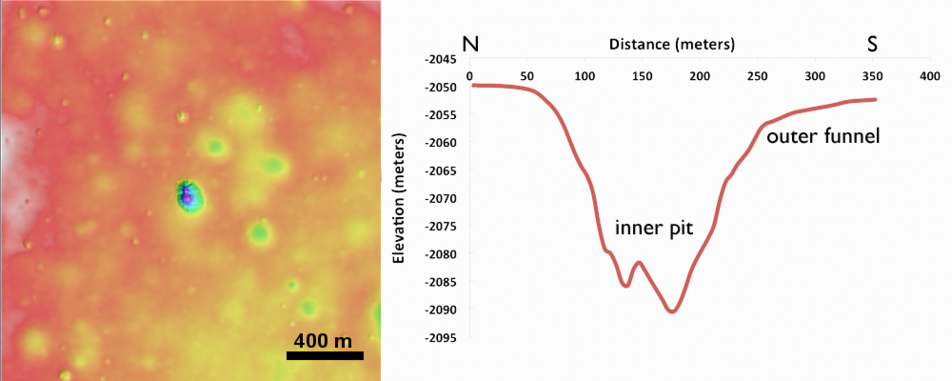
Eight mare pits have been discovered so far on the Moon, five of which preserve void spaces (sublunarean voids) beneath overhanging mare layers. The pit featured above, located in central Mare Fecunditatis (48.660°E, 0.917°S), however, does not have an obvious void space. The pit is almost 200 m wide and about 45 m deep.
The central Mare Fecunditatis pit has a concave shape, with gentler slopes (outer funnel) near the upper mare surface, and a steeper-walled inner pit (see image below). Variations in wall slopes are consistent with a fine-grained, particulate layer (regolith) overlying more coherent mare layers. The steep inner pit suggests collapse into a small void space. The debris in the pit floor consists of both regolith and mare blocks from the upper layers.

The lack of raised rim or ejecta around the pit, indicates that it most likely formed through collapse, rather than as an impact event. While this pit is not located near any obvious tectonic features or volcanic constructs, the collapse may have occurred into part of an old lava tube. The crispness of the pit morphology, suggests that the collapse occurred relatively recently (geologicially speaking, at least), perhaps much less than 1 billion years ago. Pits are among some of the youngest landforms on the Moon, and are similar in age to many fresh craters (such as Tycho, Copernicus, or Aristarchus).
Read More About Lunar Pits:
Lunar pits were recently featured in the news and the focus of a scientific publication (Wagner, R. V., and Robinson, M. S., 2014, DOI: 10.1016/j.icarus.2014.04.002). The pits are of particular interest to lunar scientists because they could offer access to subsurface materials, making them important targets for further research and exploration.
Explore the pit by panning and zooming below (LROC NAC M1105602888R):
More Pits:
New Views of Lunar Pits
Impact Melt Pit
Depths of Mare Ingenii
Marius Hills Pit - Lava Tube Skylight?
Sublunarean void!
Copernicus Collapse
Louville D
How Common are Mare Pit Craters?
Published by J. Stopar on 27 August 2014